Hospitality, Tourism, Events Environment Report: Historic Royal Places
VerifiedAdded on 2023/06/12
|11
|3356
|446
Report
AI Summary
This report provides an analysis of the hospitality, tourism, and events environment at Historic Royal Places, a UK-based independent charity managing royal sites. It covers key aspects such as consumer trends, including safety and hygiene, increased leisure focus, contactless payment, and a shift to local tourism. The report also examines the organization's sustainable performance through energy conservation, waste reduction, and the use of organic amenities. Furthermore, it details the financial operations managed by financial managers, including operational tracking, annual budgeting, and financial reporting. The governance structure, led by a board of trustees, and stakeholder relationships are also discussed, along with current issues faced by Historic Royal Places in the hospitality and tourism sector. The report emphasizes the importance of adapting to changing consumer preferences and maintaining sustainable practices to enhance the visitor experience and ensure long-term success.
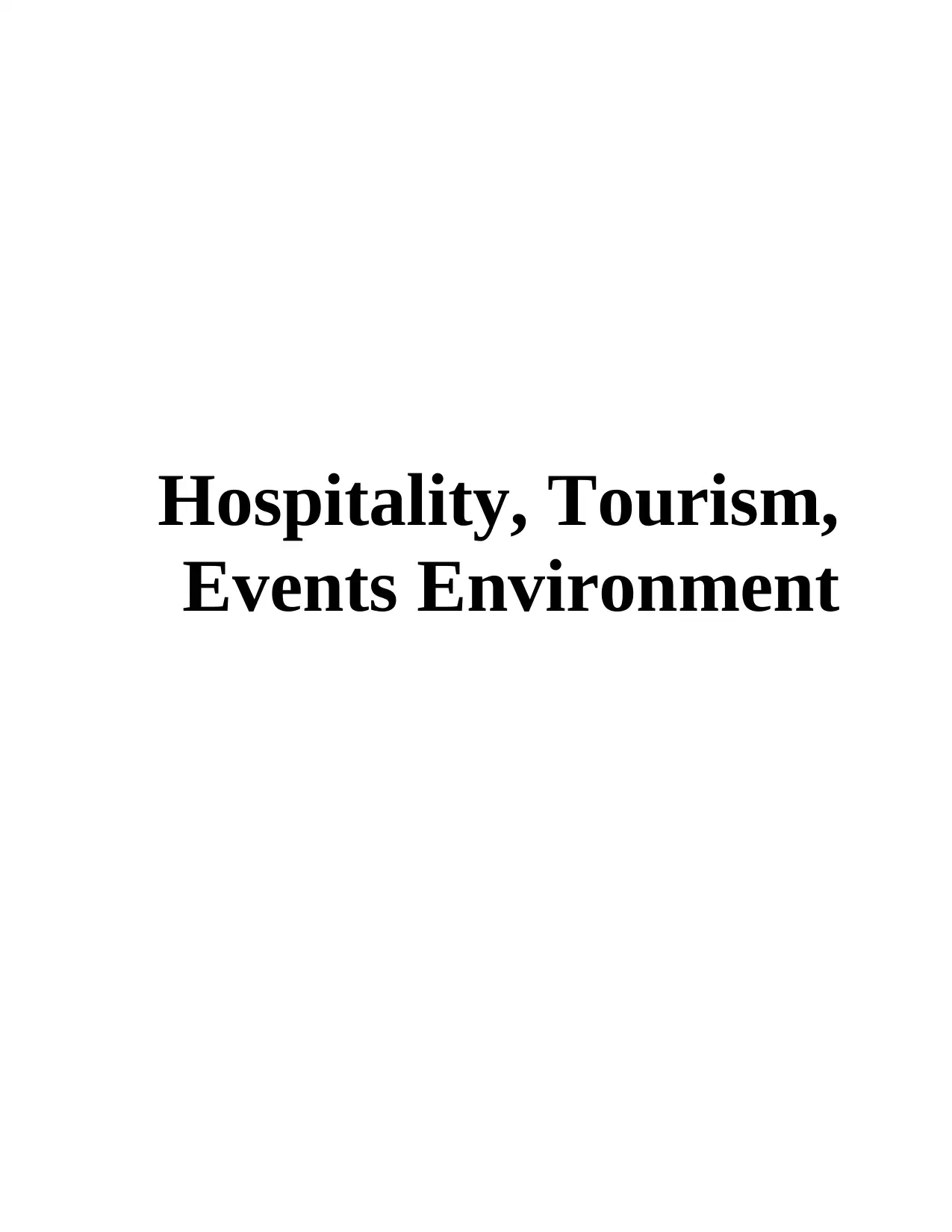
Hospitality, Tourism,
Events Environment
Events Environment
Paraphrase This Document
Need a fresh take? Get an instant paraphrase of this document with our AI Paraphraser
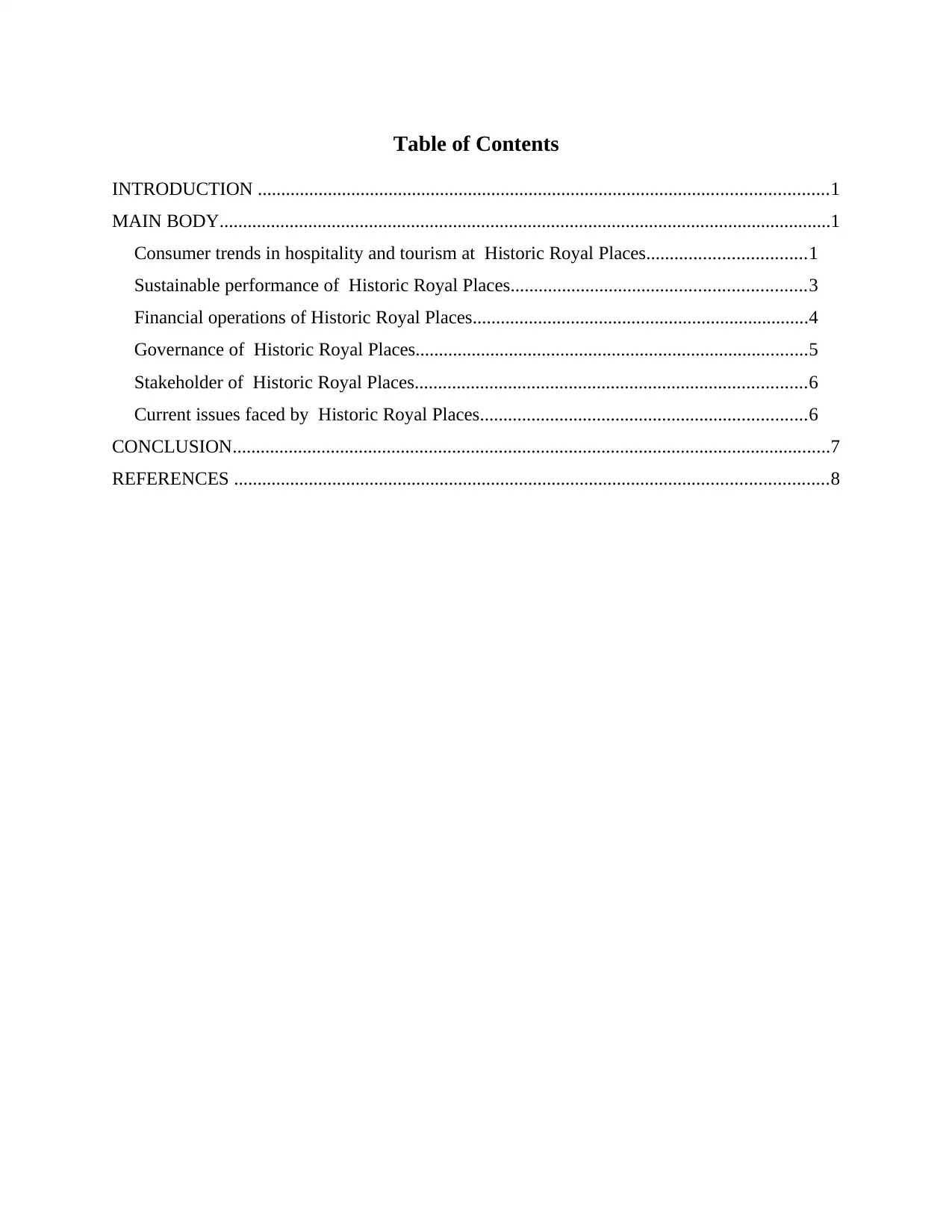
Table of Contents
INTRODUCTION ..........................................................................................................................1
MAIN BODY...................................................................................................................................1
Consumer trends in hospitality and tourism at Historic Royal Places..................................1
Sustainable performance of Historic Royal Places...............................................................3
Financial operations of Historic Royal Places........................................................................4
Governance of Historic Royal Places....................................................................................5
Stakeholder of Historic Royal Places....................................................................................6
Current issues faced by Historic Royal Places......................................................................6
CONCLUSION................................................................................................................................7
REFERENCES ...............................................................................................................................8
INTRODUCTION ..........................................................................................................................1
MAIN BODY...................................................................................................................................1
Consumer trends in hospitality and tourism at Historic Royal Places..................................1
Sustainable performance of Historic Royal Places...............................................................3
Financial operations of Historic Royal Places........................................................................4
Governance of Historic Royal Places....................................................................................5
Stakeholder of Historic Royal Places....................................................................................6
Current issues faced by Historic Royal Places......................................................................6
CONCLUSION................................................................................................................................7
REFERENCES ...............................................................................................................................8
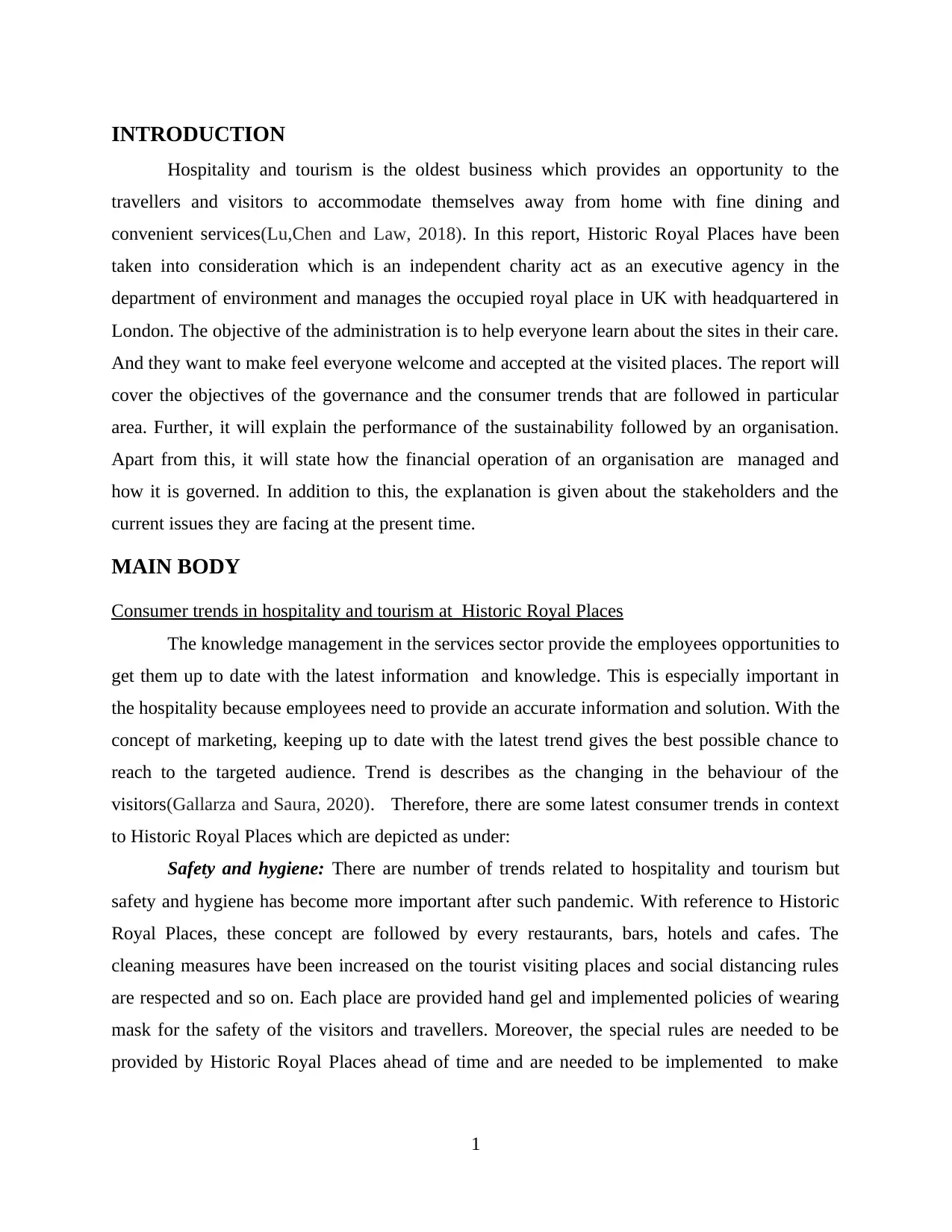
INTRODUCTION
Hospitality and tourism is the oldest business which provides an opportunity to the
travellers and visitors to accommodate themselves away from home with fine dining and
convenient services(Lu,Chen and Law, 2018). In this report, Historic Royal Places have been
taken into consideration which is an independent charity act as an executive agency in the
department of environment and manages the occupied royal place in UK with headquartered in
London. The objective of the administration is to help everyone learn about the sites in their care.
And they want to make feel everyone welcome and accepted at the visited places. The report will
cover the objectives of the governance and the consumer trends that are followed in particular
area. Further, it will explain the performance of the sustainability followed by an organisation.
Apart from this, it will state how the financial operation of an organisation are managed and
how it is governed. In addition to this, the explanation is given about the stakeholders and the
current issues they are facing at the present time.
MAIN BODY
Consumer trends in hospitality and tourism at Historic Royal Places
The knowledge management in the services sector provide the employees opportunities to
get them up to date with the latest information and knowledge. This is especially important in
the hospitality because employees need to provide an accurate information and solution. With the
concept of marketing, keeping up to date with the latest trend gives the best possible chance to
reach to the targeted audience. Trend is describes as the changing in the behaviour of the
visitors(Gallarza and Saura, 2020). Therefore, there are some latest consumer trends in context
to Historic Royal Places which are depicted as under:
Safety and hygiene: There are number of trends related to hospitality and tourism but
safety and hygiene has become more important after such pandemic. With reference to Historic
Royal Places, these concept are followed by every restaurants, bars, hotels and cafes. The
cleaning measures have been increased on the tourist visiting places and social distancing rules
are respected and so on. Each place are provided hand gel and implemented policies of wearing
mask for the safety of the visitors and travellers. Moreover, the special rules are needed to be
provided by Historic Royal Places ahead of time and are needed to be implemented to make
1
Hospitality and tourism is the oldest business which provides an opportunity to the
travellers and visitors to accommodate themselves away from home with fine dining and
convenient services(Lu,Chen and Law, 2018). In this report, Historic Royal Places have been
taken into consideration which is an independent charity act as an executive agency in the
department of environment and manages the occupied royal place in UK with headquartered in
London. The objective of the administration is to help everyone learn about the sites in their care.
And they want to make feel everyone welcome and accepted at the visited places. The report will
cover the objectives of the governance and the consumer trends that are followed in particular
area. Further, it will explain the performance of the sustainability followed by an organisation.
Apart from this, it will state how the financial operation of an organisation are managed and
how it is governed. In addition to this, the explanation is given about the stakeholders and the
current issues they are facing at the present time.
MAIN BODY
Consumer trends in hospitality and tourism at Historic Royal Places
The knowledge management in the services sector provide the employees opportunities to
get them up to date with the latest information and knowledge. This is especially important in
the hospitality because employees need to provide an accurate information and solution. With the
concept of marketing, keeping up to date with the latest trend gives the best possible chance to
reach to the targeted audience. Trend is describes as the changing in the behaviour of the
visitors(Gallarza and Saura, 2020). Therefore, there are some latest consumer trends in context
to Historic Royal Places which are depicted as under:
Safety and hygiene: There are number of trends related to hospitality and tourism but
safety and hygiene has become more important after such pandemic. With reference to Historic
Royal Places, these concept are followed by every restaurants, bars, hotels and cafes. The
cleaning measures have been increased on the tourist visiting places and social distancing rules
are respected and so on. Each place are provided hand gel and implemented policies of wearing
mask for the safety of the visitors and travellers. Moreover, the special rules are needed to be
provided by Historic Royal Places ahead of time and are needed to be implemented to make
1
⊘ This is a preview!⊘
Do you want full access?
Subscribe today to unlock all pages.

Trusted by 1+ million students worldwide
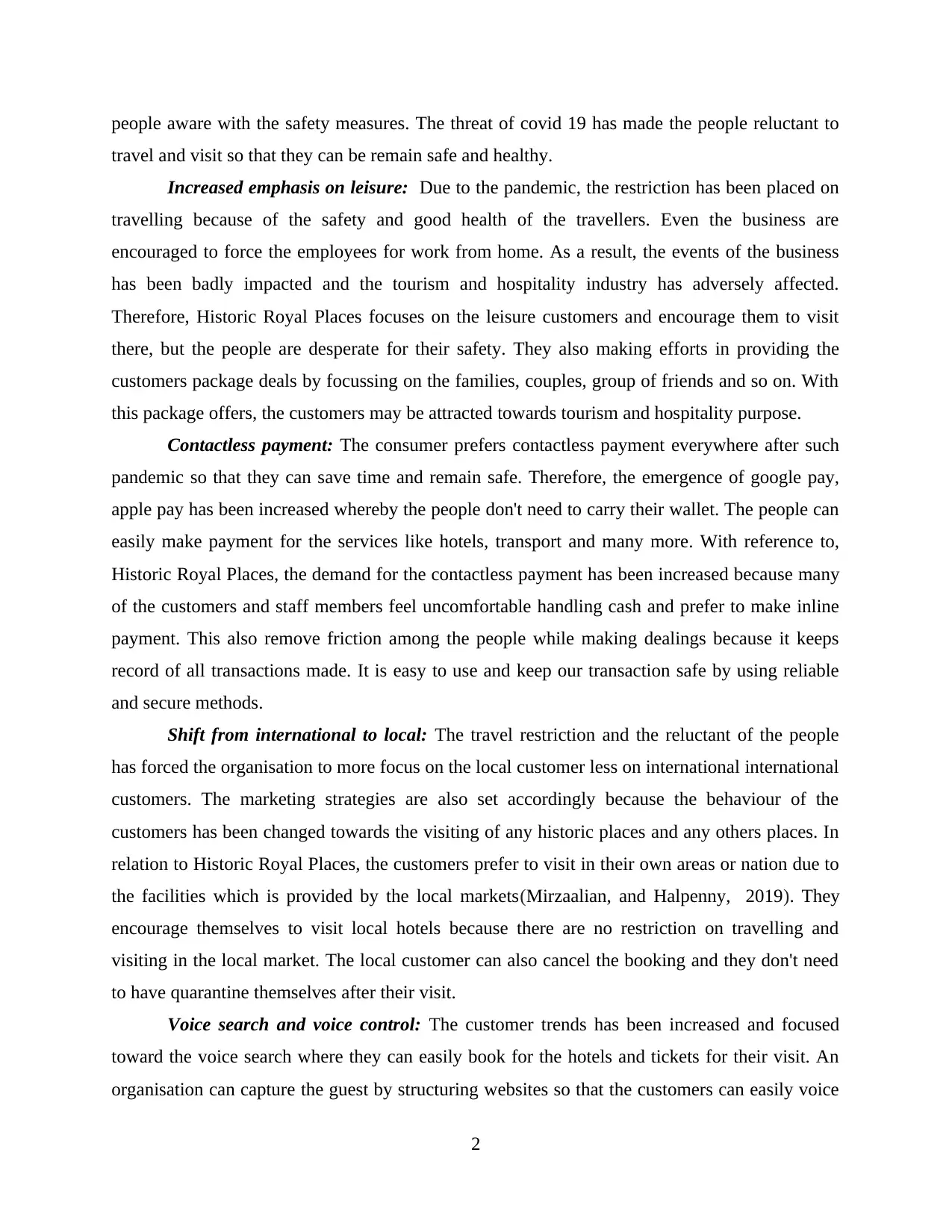
people aware with the safety measures. The threat of covid 19 has made the people reluctant to
travel and visit so that they can be remain safe and healthy.
Increased emphasis on leisure: Due to the pandemic, the restriction has been placed on
travelling because of the safety and good health of the travellers. Even the business are
encouraged to force the employees for work from home. As a result, the events of the business
has been badly impacted and the tourism and hospitality industry has adversely affected.
Therefore, Historic Royal Places focuses on the leisure customers and encourage them to visit
there, but the people are desperate for their safety. They also making efforts in providing the
customers package deals by focussing on the families, couples, group of friends and so on. With
this package offers, the customers may be attracted towards tourism and hospitality purpose.
Contactless payment: The consumer prefers contactless payment everywhere after such
pandemic so that they can save time and remain safe. Therefore, the emergence of google pay,
apple pay has been increased whereby the people don't need to carry their wallet. The people can
easily make payment for the services like hotels, transport and many more. With reference to,
Historic Royal Places, the demand for the contactless payment has been increased because many
of the customers and staff members feel uncomfortable handling cash and prefer to make inline
payment. This also remove friction among the people while making dealings because it keeps
record of all transactions made. It is easy to use and keep our transaction safe by using reliable
and secure methods.
Shift from international to local: The travel restriction and the reluctant of the people
has forced the organisation to more focus on the local customer less on international international
customers. The marketing strategies are also set accordingly because the behaviour of the
customers has been changed towards the visiting of any historic places and any others places. In
relation to Historic Royal Places, the customers prefer to visit in their own areas or nation due to
the facilities which is provided by the local markets(Mirzaalian, and Halpenny, 2019). They
encourage themselves to visit local hotels because there are no restriction on travelling and
visiting in the local market. The local customer can also cancel the booking and they don't need
to have quarantine themselves after their visit.
Voice search and voice control: The customer trends has been increased and focused
toward the voice search where they can easily book for the hotels and tickets for their visit. An
organisation can capture the guest by structuring websites so that the customers can easily voice
2
travel and visit so that they can be remain safe and healthy.
Increased emphasis on leisure: Due to the pandemic, the restriction has been placed on
travelling because of the safety and good health of the travellers. Even the business are
encouraged to force the employees for work from home. As a result, the events of the business
has been badly impacted and the tourism and hospitality industry has adversely affected.
Therefore, Historic Royal Places focuses on the leisure customers and encourage them to visit
there, but the people are desperate for their safety. They also making efforts in providing the
customers package deals by focussing on the families, couples, group of friends and so on. With
this package offers, the customers may be attracted towards tourism and hospitality purpose.
Contactless payment: The consumer prefers contactless payment everywhere after such
pandemic so that they can save time and remain safe. Therefore, the emergence of google pay,
apple pay has been increased whereby the people don't need to carry their wallet. The people can
easily make payment for the services like hotels, transport and many more. With reference to,
Historic Royal Places, the demand for the contactless payment has been increased because many
of the customers and staff members feel uncomfortable handling cash and prefer to make inline
payment. This also remove friction among the people while making dealings because it keeps
record of all transactions made. It is easy to use and keep our transaction safe by using reliable
and secure methods.
Shift from international to local: The travel restriction and the reluctant of the people
has forced the organisation to more focus on the local customer less on international international
customers. The marketing strategies are also set accordingly because the behaviour of the
customers has been changed towards the visiting of any historic places and any others places. In
relation to Historic Royal Places, the customers prefer to visit in their own areas or nation due to
the facilities which is provided by the local markets(Mirzaalian, and Halpenny, 2019). They
encourage themselves to visit local hotels because there are no restriction on travelling and
visiting in the local market. The local customer can also cancel the booking and they don't need
to have quarantine themselves after their visit.
Voice search and voice control: The customer trends has been increased and focused
toward the voice search where they can easily book for the hotels and tickets for their visit. An
organisation can capture the guest by structuring websites so that the customers can easily voice
2
Paraphrase This Document
Need a fresh take? Get an instant paraphrase of this document with our AI Paraphraser
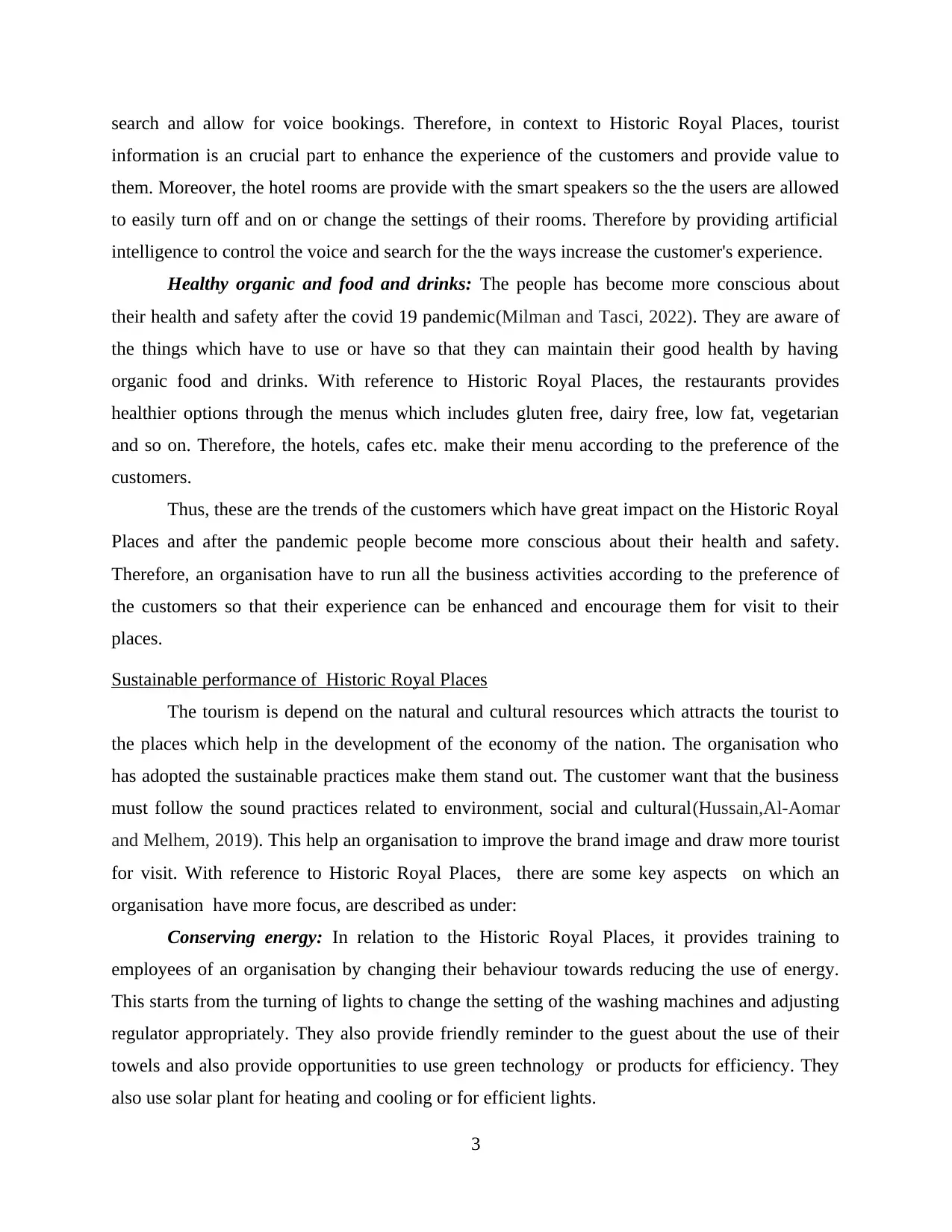
search and allow for voice bookings. Therefore, in context to Historic Royal Places, tourist
information is an crucial part to enhance the experience of the customers and provide value to
them. Moreover, the hotel rooms are provide with the smart speakers so the the users are allowed
to easily turn off and on or change the settings of their rooms. Therefore by providing artificial
intelligence to control the voice and search for the the ways increase the customer's experience.
Healthy organic and food and drinks: The people has become more conscious about
their health and safety after the covid 19 pandemic(Milman and Tasci, 2022). They are aware of
the things which have to use or have so that they can maintain their good health by having
organic food and drinks. With reference to Historic Royal Places, the restaurants provides
healthier options through the menus which includes gluten free, dairy free, low fat, vegetarian
and so on. Therefore, the hotels, cafes etc. make their menu according to the preference of the
customers.
Thus, these are the trends of the customers which have great impact on the Historic Royal
Places and after the pandemic people become more conscious about their health and safety.
Therefore, an organisation have to run all the business activities according to the preference of
the customers so that their experience can be enhanced and encourage them for visit to their
places.
Sustainable performance of Historic Royal Places
The tourism is depend on the natural and cultural resources which attracts the tourist to
the places which help in the development of the economy of the nation. The organisation who
has adopted the sustainable practices make them stand out. The customer want that the business
must follow the sound practices related to environment, social and cultural(Hussain,Al-Aomar
and Melhem, 2019). This help an organisation to improve the brand image and draw more tourist
for visit. With reference to Historic Royal Places, there are some key aspects on which an
organisation have more focus, are described as under:
Conserving energy: In relation to the Historic Royal Places, it provides training to
employees of an organisation by changing their behaviour towards reducing the use of energy.
This starts from the turning of lights to change the setting of the washing machines and adjusting
regulator appropriately. They also provide friendly reminder to the guest about the use of their
towels and also provide opportunities to use green technology or products for efficiency. They
also use solar plant for heating and cooling or for efficient lights.
3
information is an crucial part to enhance the experience of the customers and provide value to
them. Moreover, the hotel rooms are provide with the smart speakers so the the users are allowed
to easily turn off and on or change the settings of their rooms. Therefore by providing artificial
intelligence to control the voice and search for the the ways increase the customer's experience.
Healthy organic and food and drinks: The people has become more conscious about
their health and safety after the covid 19 pandemic(Milman and Tasci, 2022). They are aware of
the things which have to use or have so that they can maintain their good health by having
organic food and drinks. With reference to Historic Royal Places, the restaurants provides
healthier options through the menus which includes gluten free, dairy free, low fat, vegetarian
and so on. Therefore, the hotels, cafes etc. make their menu according to the preference of the
customers.
Thus, these are the trends of the customers which have great impact on the Historic Royal
Places and after the pandemic people become more conscious about their health and safety.
Therefore, an organisation have to run all the business activities according to the preference of
the customers so that their experience can be enhanced and encourage them for visit to their
places.
Sustainable performance of Historic Royal Places
The tourism is depend on the natural and cultural resources which attracts the tourist to
the places which help in the development of the economy of the nation. The organisation who
has adopted the sustainable practices make them stand out. The customer want that the business
must follow the sound practices related to environment, social and cultural(Hussain,Al-Aomar
and Melhem, 2019). This help an organisation to improve the brand image and draw more tourist
for visit. With reference to Historic Royal Places, there are some key aspects on which an
organisation have more focus, are described as under:
Conserving energy: In relation to the Historic Royal Places, it provides training to
employees of an organisation by changing their behaviour towards reducing the use of energy.
This starts from the turning of lights to change the setting of the washing machines and adjusting
regulator appropriately. They also provide friendly reminder to the guest about the use of their
towels and also provide opportunities to use green technology or products for efficiency. They
also use solar plant for heating and cooling or for efficient lights.
3
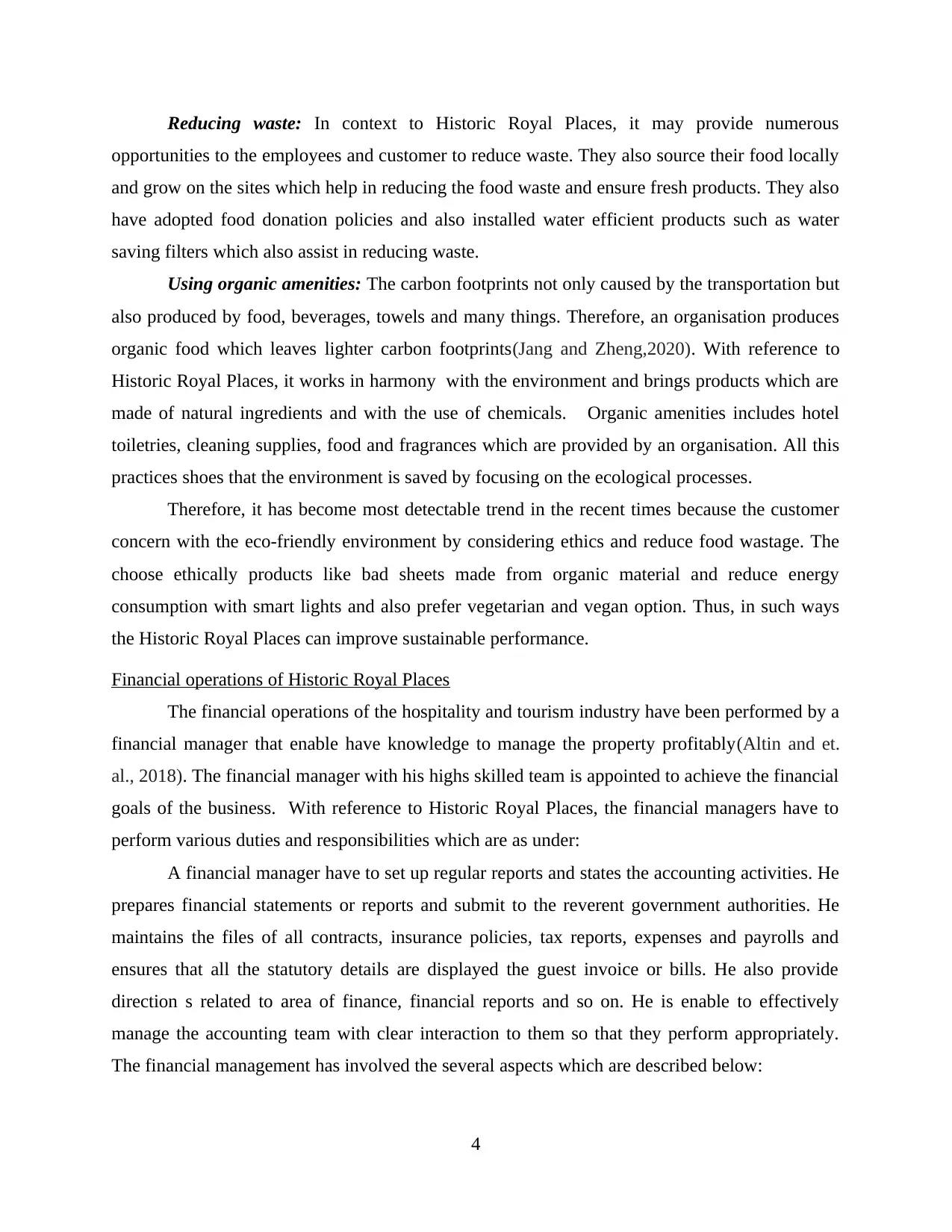
Reducing waste: In context to Historic Royal Places, it may provide numerous
opportunities to the employees and customer to reduce waste. They also source their food locally
and grow on the sites which help in reducing the food waste and ensure fresh products. They also
have adopted food donation policies and also installed water efficient products such as water
saving filters which also assist in reducing waste.
Using organic amenities: The carbon footprints not only caused by the transportation but
also produced by food, beverages, towels and many things. Therefore, an organisation produces
organic food which leaves lighter carbon footprints(Jang and Zheng,2020). With reference to
Historic Royal Places, it works in harmony with the environment and brings products which are
made of natural ingredients and with the use of chemicals. Organic amenities includes hotel
toiletries, cleaning supplies, food and fragrances which are provided by an organisation. All this
practices shoes that the environment is saved by focusing on the ecological processes.
Therefore, it has become most detectable trend in the recent times because the customer
concern with the eco-friendly environment by considering ethics and reduce food wastage. The
choose ethically products like bad sheets made from organic material and reduce energy
consumption with smart lights and also prefer vegetarian and vegan option. Thus, in such ways
the Historic Royal Places can improve sustainable performance.
Financial operations of Historic Royal Places
The financial operations of the hospitality and tourism industry have been performed by a
financial manager that enable have knowledge to manage the property profitably(Altin and et.
al., 2018). The financial manager with his highs skilled team is appointed to achieve the financial
goals of the business. With reference to Historic Royal Places, the financial managers have to
perform various duties and responsibilities which are as under:
A financial manager have to set up regular reports and states the accounting activities. He
prepares financial statements or reports and submit to the reverent government authorities. He
maintains the files of all contracts, insurance policies, tax reports, expenses and payrolls and
ensures that all the statutory details are displayed the guest invoice or bills. He also provide
direction s related to area of finance, financial reports and so on. He is enable to effectively
manage the accounting team with clear interaction to them so that they perform appropriately.
The financial management has involved the several aspects which are described below:
4
opportunities to the employees and customer to reduce waste. They also source their food locally
and grow on the sites which help in reducing the food waste and ensure fresh products. They also
have adopted food donation policies and also installed water efficient products such as water
saving filters which also assist in reducing waste.
Using organic amenities: The carbon footprints not only caused by the transportation but
also produced by food, beverages, towels and many things. Therefore, an organisation produces
organic food which leaves lighter carbon footprints(Jang and Zheng,2020). With reference to
Historic Royal Places, it works in harmony with the environment and brings products which are
made of natural ingredients and with the use of chemicals. Organic amenities includes hotel
toiletries, cleaning supplies, food and fragrances which are provided by an organisation. All this
practices shoes that the environment is saved by focusing on the ecological processes.
Therefore, it has become most detectable trend in the recent times because the customer
concern with the eco-friendly environment by considering ethics and reduce food wastage. The
choose ethically products like bad sheets made from organic material and reduce energy
consumption with smart lights and also prefer vegetarian and vegan option. Thus, in such ways
the Historic Royal Places can improve sustainable performance.
Financial operations of Historic Royal Places
The financial operations of the hospitality and tourism industry have been performed by a
financial manager that enable have knowledge to manage the property profitably(Altin and et.
al., 2018). The financial manager with his highs skilled team is appointed to achieve the financial
goals of the business. With reference to Historic Royal Places, the financial managers have to
perform various duties and responsibilities which are as under:
A financial manager have to set up regular reports and states the accounting activities. He
prepares financial statements or reports and submit to the reverent government authorities. He
maintains the files of all contracts, insurance policies, tax reports, expenses and payrolls and
ensures that all the statutory details are displayed the guest invoice or bills. He also provide
direction s related to area of finance, financial reports and so on. He is enable to effectively
manage the accounting team with clear interaction to them so that they perform appropriately.
The financial management has involved the several aspects which are described below:
4
⊘ This is a preview!⊘
Do you want full access?
Subscribe today to unlock all pages.

Trusted by 1+ million students worldwide
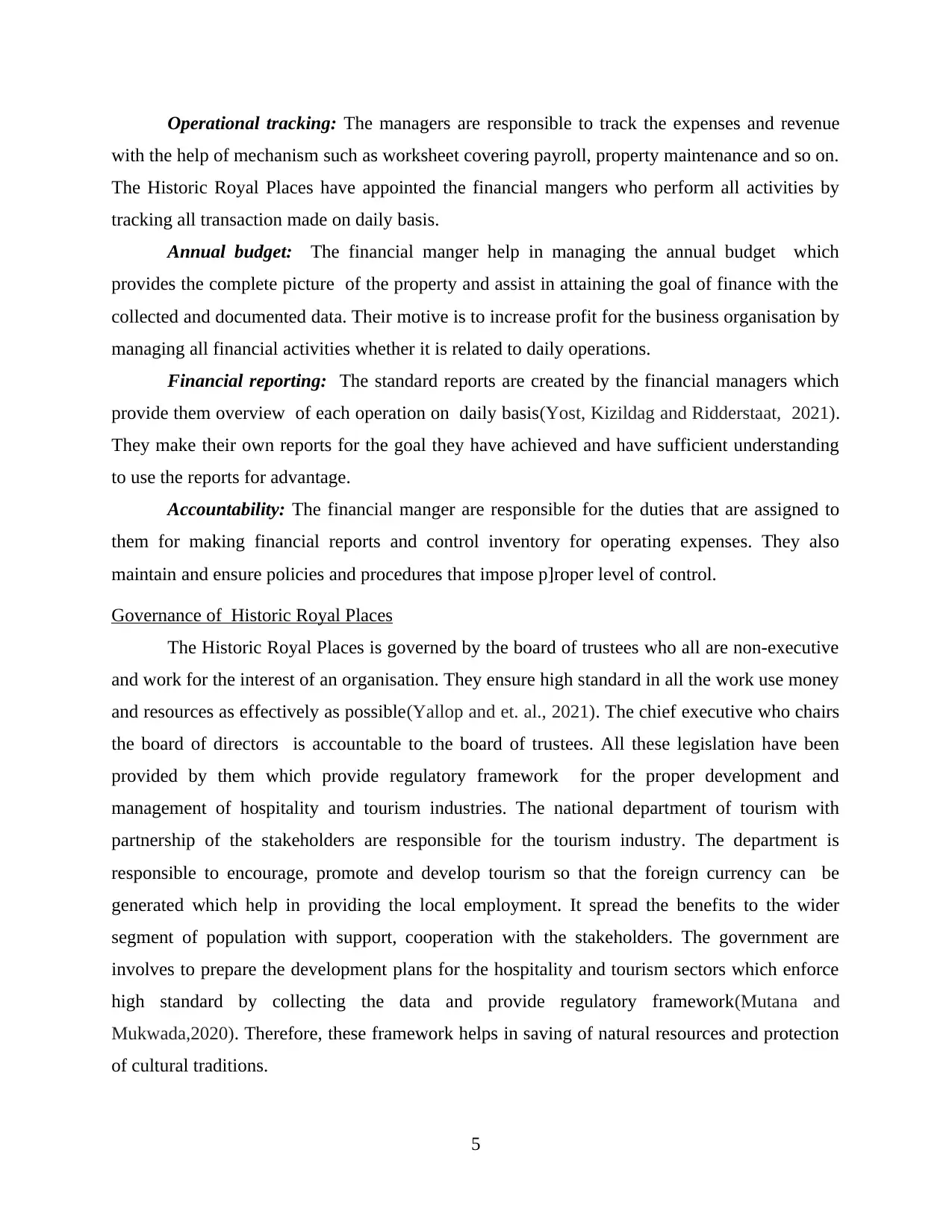
Operational tracking: The managers are responsible to track the expenses and revenue
with the help of mechanism such as worksheet covering payroll, property maintenance and so on.
The Historic Royal Places have appointed the financial mangers who perform all activities by
tracking all transaction made on daily basis.
Annual budget: The financial manger help in managing the annual budget which
provides the complete picture of the property and assist in attaining the goal of finance with the
collected and documented data. Their motive is to increase profit for the business organisation by
managing all financial activities whether it is related to daily operations.
Financial reporting: The standard reports are created by the financial managers which
provide them overview of each operation on daily basis(Yost, Kizildag and Ridderstaat, 2021).
They make their own reports for the goal they have achieved and have sufficient understanding
to use the reports for advantage.
Accountability: The financial manger are responsible for the duties that are assigned to
them for making financial reports and control inventory for operating expenses. They also
maintain and ensure policies and procedures that impose p]roper level of control.
Governance of Historic Royal Places
The Historic Royal Places is governed by the board of trustees who all are non-executive
and work for the interest of an organisation. They ensure high standard in all the work use money
and resources as effectively as possible(Yallop and et. al., 2021). The chief executive who chairs
the board of directors is accountable to the board of trustees. All these legislation have been
provided by them which provide regulatory framework for the proper development and
management of hospitality and tourism industries. The national department of tourism with
partnership of the stakeholders are responsible for the tourism industry. The department is
responsible to encourage, promote and develop tourism so that the foreign currency can be
generated which help in providing the local employment. It spread the benefits to the wider
segment of population with support, cooperation with the stakeholders. The government are
involves to prepare the development plans for the hospitality and tourism sectors which enforce
high standard by collecting the data and provide regulatory framework(Mutana and
Mukwada,2020). Therefore, these framework helps in saving of natural resources and protection
of cultural traditions.
5
with the help of mechanism such as worksheet covering payroll, property maintenance and so on.
The Historic Royal Places have appointed the financial mangers who perform all activities by
tracking all transaction made on daily basis.
Annual budget: The financial manger help in managing the annual budget which
provides the complete picture of the property and assist in attaining the goal of finance with the
collected and documented data. Their motive is to increase profit for the business organisation by
managing all financial activities whether it is related to daily operations.
Financial reporting: The standard reports are created by the financial managers which
provide them overview of each operation on daily basis(Yost, Kizildag and Ridderstaat, 2021).
They make their own reports for the goal they have achieved and have sufficient understanding
to use the reports for advantage.
Accountability: The financial manger are responsible for the duties that are assigned to
them for making financial reports and control inventory for operating expenses. They also
maintain and ensure policies and procedures that impose p]roper level of control.
Governance of Historic Royal Places
The Historic Royal Places is governed by the board of trustees who all are non-executive
and work for the interest of an organisation. They ensure high standard in all the work use money
and resources as effectively as possible(Yallop and et. al., 2021). The chief executive who chairs
the board of directors is accountable to the board of trustees. All these legislation have been
provided by them which provide regulatory framework for the proper development and
management of hospitality and tourism industries. The national department of tourism with
partnership of the stakeholders are responsible for the tourism industry. The department is
responsible to encourage, promote and develop tourism so that the foreign currency can be
generated which help in providing the local employment. It spread the benefits to the wider
segment of population with support, cooperation with the stakeholders. The government are
involves to prepare the development plans for the hospitality and tourism sectors which enforce
high standard by collecting the data and provide regulatory framework(Mutana and
Mukwada,2020). Therefore, these framework helps in saving of natural resources and protection
of cultural traditions.
5
Paraphrase This Document
Need a fresh take? Get an instant paraphrase of this document with our AI Paraphraser

Stakeholder of Historic Royal Places
A stakeholder is one who is involved in particular project of an organisation. He can be
individual or a group of individuals who can be impacted by the outcome of the
projects(Schimperna, Lombardi and Belyaeva, 2020). There are some stakeholder who are
involved in the tourism industry which are described as under:
Government: It plays important role because it makes various policies for the hospitality
of the tourist and clean and safe environment. The policies are also made for the infrastructure
of the public and all its business are operated with the help of the government.
Tourist: They are the important part of the tourist industries because without them there
will be no tourism.
Employees: They also provide their service of hospitality, catering and customer
services(Deale and Lee, 2021).
Thus, there are various stakeholder of Historic Royal Places that includes the royal family
and riyal household, government department for digital, culture, media & sport, secretariat of
state and ministers and chairs of other organisation.
Current issues faced by Historic Royal Places
There are some issues which are faced by Historic Royal Places that depicted as under:
Housekeeping: This is the most common challenge because every hotel requires
qualified staff for maintenance kitchen, front desk, guiding and so on(Bec and et. al., 2021). But
some time they have to face less skilled staff for which they have to provide training and inured
extra cost.
Operational issues: There are lot of operational issues which an organisation have to face
such as attend guest, perform all front office operation, maintain cleanliness in room and
premises and many more. When the department fails to perform all these task then this may
create problem and get bad experience from the customers.
Data security challenges: Sometimes the management have to face the challenge of
security of data that may be hacked by the competitors or for misuse purpose(Scheyvens and
Hughes, 2019). This may create trouble because the confidential information can be used for
malicious purpose by the hackers.
6
A stakeholder is one who is involved in particular project of an organisation. He can be
individual or a group of individuals who can be impacted by the outcome of the
projects(Schimperna, Lombardi and Belyaeva, 2020). There are some stakeholder who are
involved in the tourism industry which are described as under:
Government: It plays important role because it makes various policies for the hospitality
of the tourist and clean and safe environment. The policies are also made for the infrastructure
of the public and all its business are operated with the help of the government.
Tourist: They are the important part of the tourist industries because without them there
will be no tourism.
Employees: They also provide their service of hospitality, catering and customer
services(Deale and Lee, 2021).
Thus, there are various stakeholder of Historic Royal Places that includes the royal family
and riyal household, government department for digital, culture, media & sport, secretariat of
state and ministers and chairs of other organisation.
Current issues faced by Historic Royal Places
There are some issues which are faced by Historic Royal Places that depicted as under:
Housekeeping: This is the most common challenge because every hotel requires
qualified staff for maintenance kitchen, front desk, guiding and so on(Bec and et. al., 2021). But
some time they have to face less skilled staff for which they have to provide training and inured
extra cost.
Operational issues: There are lot of operational issues which an organisation have to face
such as attend guest, perform all front office operation, maintain cleanliness in room and
premises and many more. When the department fails to perform all these task then this may
create problem and get bad experience from the customers.
Data security challenges: Sometimes the management have to face the challenge of
security of data that may be hacked by the competitors or for misuse purpose(Scheyvens and
Hughes, 2019). This may create trouble because the confidential information can be used for
malicious purpose by the hackers.
6

CONCLUSION
From the above discussion, it has been concluded that the tourism and hospitality
industries provide various opportunities to the traveller and visitors. It also generate revenues
which are used by the government for the development of the historic places and creates
thousand of jobs. It also help in developing the infrastructure of a country and provide
opportunities of cultural exchange between the citizens and foreigners. The report has explained
the consumer trends the are followed in the tourist and hospitality sectors which have great
impacted after the covid 19 pandemic. Further, it has explained the responsibilities of
sustainability that is performed by an organisation. Apart from this, it has stated the financial
operation that are performed by a financial manager of Historic Royal Places and also explained
the governance . In addition to this, it has discussion about the stakeholders such as government,
employees, tourist and so on.
7
From the above discussion, it has been concluded that the tourism and hospitality
industries provide various opportunities to the traveller and visitors. It also generate revenues
which are used by the government for the development of the historic places and creates
thousand of jobs. It also help in developing the infrastructure of a country and provide
opportunities of cultural exchange between the citizens and foreigners. The report has explained
the consumer trends the are followed in the tourist and hospitality sectors which have great
impacted after the covid 19 pandemic. Further, it has explained the responsibilities of
sustainability that is performed by an organisation. Apart from this, it has stated the financial
operation that are performed by a financial manager of Historic Royal Places and also explained
the governance . In addition to this, it has discussion about the stakeholders such as government,
employees, tourist and so on.
7
⊘ This is a preview!⊘
Do you want full access?
Subscribe today to unlock all pages.

Trusted by 1+ million students worldwide
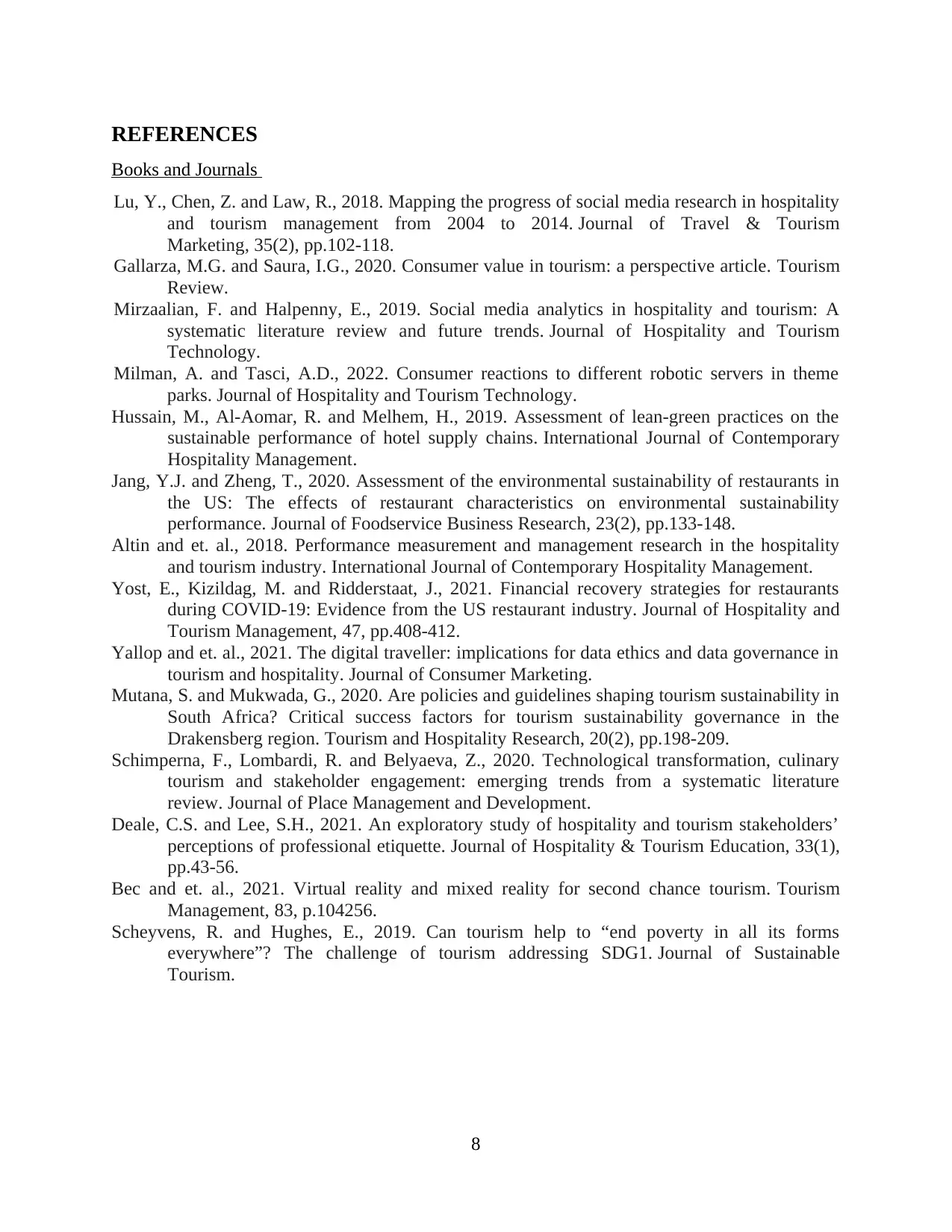
REFERENCES
Books and Journals
Lu, Y., Chen, Z. and Law, R., 2018. Mapping the progress of social media research in hospitality
and tourism management from 2004 to 2014. Journal of Travel & Tourism
Marketing, 35(2), pp.102-118.
Gallarza, M.G. and Saura, I.G., 2020. Consumer value in tourism: a perspective article. Tourism
Review.
Mirzaalian, F. and Halpenny, E., 2019. Social media analytics in hospitality and tourism: A
systematic literature review and future trends. Journal of Hospitality and Tourism
Technology.
Milman, A. and Tasci, A.D., 2022. Consumer reactions to different robotic servers in theme
parks. Journal of Hospitality and Tourism Technology.
Hussain, M., Al-Aomar, R. and Melhem, H., 2019. Assessment of lean-green practices on the
sustainable performance of hotel supply chains. International Journal of Contemporary
Hospitality Management.
Jang, Y.J. and Zheng, T., 2020. Assessment of the environmental sustainability of restaurants in
the US: The effects of restaurant characteristics on environmental sustainability
performance. Journal of Foodservice Business Research, 23(2), pp.133-148.
Altin and et. al., 2018. Performance measurement and management research in the hospitality
and tourism industry. International Journal of Contemporary Hospitality Management.
Yost, E., Kizildag, M. and Ridderstaat, J., 2021. Financial recovery strategies for restaurants
during COVID-19: Evidence from the US restaurant industry. Journal of Hospitality and
Tourism Management, 47, pp.408-412.
Yallop and et. al., 2021. The digital traveller: implications for data ethics and data governance in
tourism and hospitality. Journal of Consumer Marketing.
Mutana, S. and Mukwada, G., 2020. Are policies and guidelines shaping tourism sustainability in
South Africa? Critical success factors for tourism sustainability governance in the
Drakensberg region. Tourism and Hospitality Research, 20(2), pp.198-209.
Schimperna, F., Lombardi, R. and Belyaeva, Z., 2020. Technological transformation, culinary
tourism and stakeholder engagement: emerging trends from a systematic literature
review. Journal of Place Management and Development.
Deale, C.S. and Lee, S.H., 2021. An exploratory study of hospitality and tourism stakeholders’
perceptions of professional etiquette. Journal of Hospitality & Tourism Education, 33(1),
pp.43-56.
Bec and et. al., 2021. Virtual reality and mixed reality for second chance tourism. Tourism
Management, 83, p.104256.
Scheyvens, R. and Hughes, E., 2019. Can tourism help to “end poverty in all its forms
everywhere”? The challenge of tourism addressing SDG1. Journal of Sustainable
Tourism.
8
Books and Journals
Lu, Y., Chen, Z. and Law, R., 2018. Mapping the progress of social media research in hospitality
and tourism management from 2004 to 2014. Journal of Travel & Tourism
Marketing, 35(2), pp.102-118.
Gallarza, M.G. and Saura, I.G., 2020. Consumer value in tourism: a perspective article. Tourism
Review.
Mirzaalian, F. and Halpenny, E., 2019. Social media analytics in hospitality and tourism: A
systematic literature review and future trends. Journal of Hospitality and Tourism
Technology.
Milman, A. and Tasci, A.D., 2022. Consumer reactions to different robotic servers in theme
parks. Journal of Hospitality and Tourism Technology.
Hussain, M., Al-Aomar, R. and Melhem, H., 2019. Assessment of lean-green practices on the
sustainable performance of hotel supply chains. International Journal of Contemporary
Hospitality Management.
Jang, Y.J. and Zheng, T., 2020. Assessment of the environmental sustainability of restaurants in
the US: The effects of restaurant characteristics on environmental sustainability
performance. Journal of Foodservice Business Research, 23(2), pp.133-148.
Altin and et. al., 2018. Performance measurement and management research in the hospitality
and tourism industry. International Journal of Contemporary Hospitality Management.
Yost, E., Kizildag, M. and Ridderstaat, J., 2021. Financial recovery strategies for restaurants
during COVID-19: Evidence from the US restaurant industry. Journal of Hospitality and
Tourism Management, 47, pp.408-412.
Yallop and et. al., 2021. The digital traveller: implications for data ethics and data governance in
tourism and hospitality. Journal of Consumer Marketing.
Mutana, S. and Mukwada, G., 2020. Are policies and guidelines shaping tourism sustainability in
South Africa? Critical success factors for tourism sustainability governance in the
Drakensberg region. Tourism and Hospitality Research, 20(2), pp.198-209.
Schimperna, F., Lombardi, R. and Belyaeva, Z., 2020. Technological transformation, culinary
tourism and stakeholder engagement: emerging trends from a systematic literature
review. Journal of Place Management and Development.
Deale, C.S. and Lee, S.H., 2021. An exploratory study of hospitality and tourism stakeholders’
perceptions of professional etiquette. Journal of Hospitality & Tourism Education, 33(1),
pp.43-56.
Bec and et. al., 2021. Virtual reality and mixed reality for second chance tourism. Tourism
Management, 83, p.104256.
Scheyvens, R. and Hughes, E., 2019. Can tourism help to “end poverty in all its forms
everywhere”? The challenge of tourism addressing SDG1. Journal of Sustainable
Tourism.
8
Paraphrase This Document
Need a fresh take? Get an instant paraphrase of this document with our AI Paraphraser

9
1 out of 11
Related Documents
Your All-in-One AI-Powered Toolkit for Academic Success.
+13062052269
info@desklib.com
Available 24*7 on WhatsApp / Email
![[object Object]](/_next/static/media/star-bottom.7253800d.svg)
Unlock your academic potential
Copyright © 2020–2025 A2Z Services. All Rights Reserved. Developed and managed by ZUCOL.

